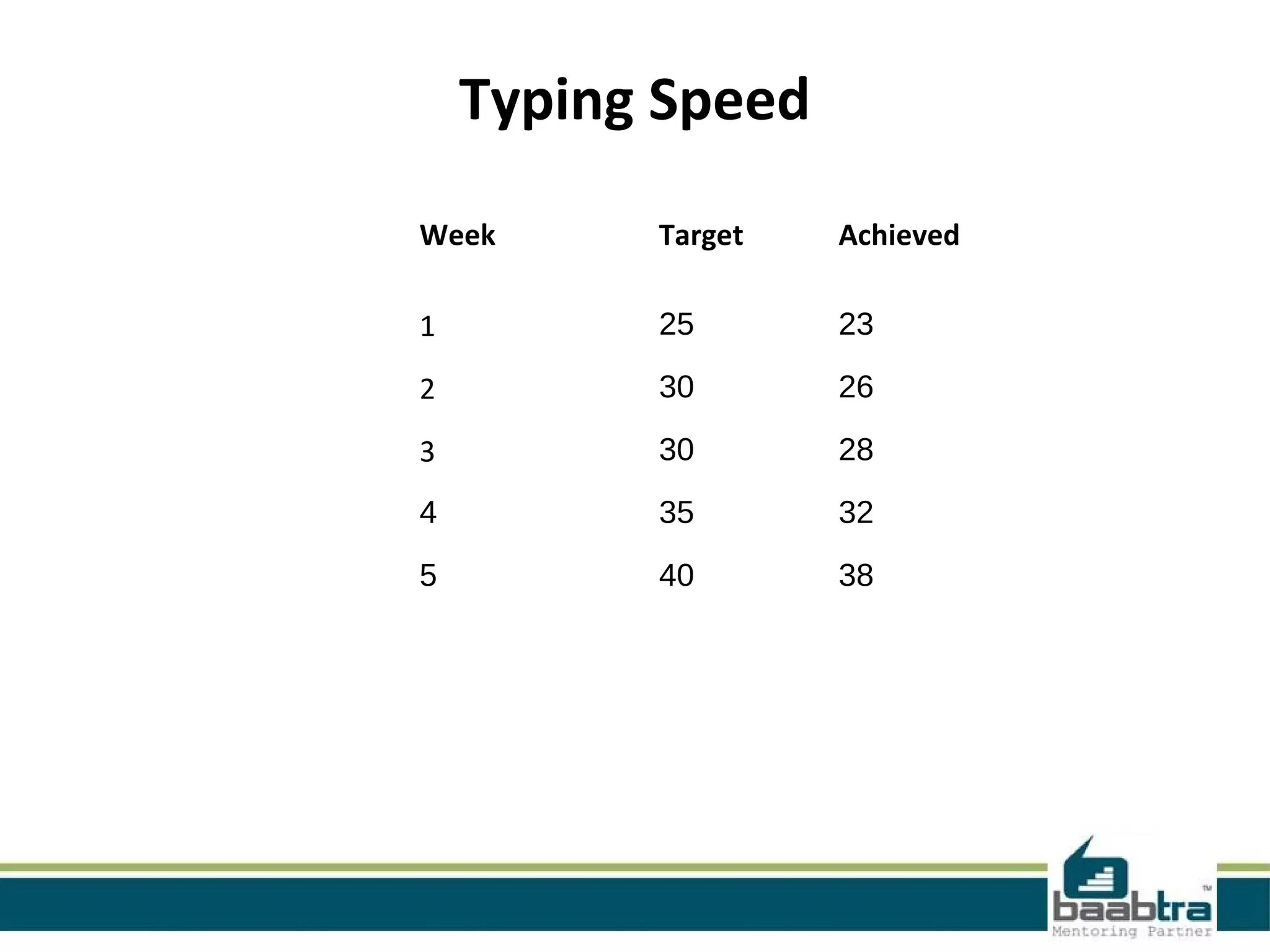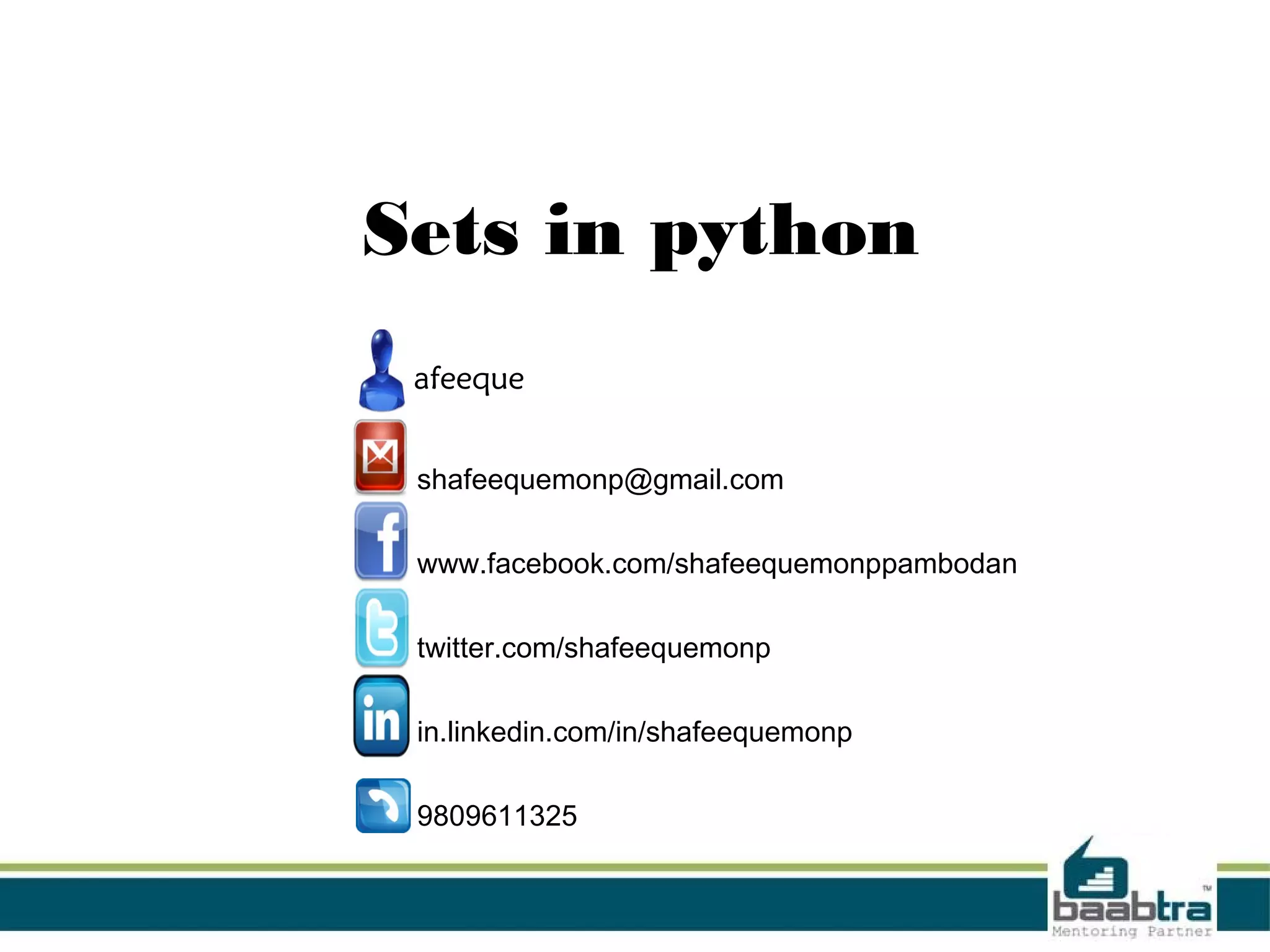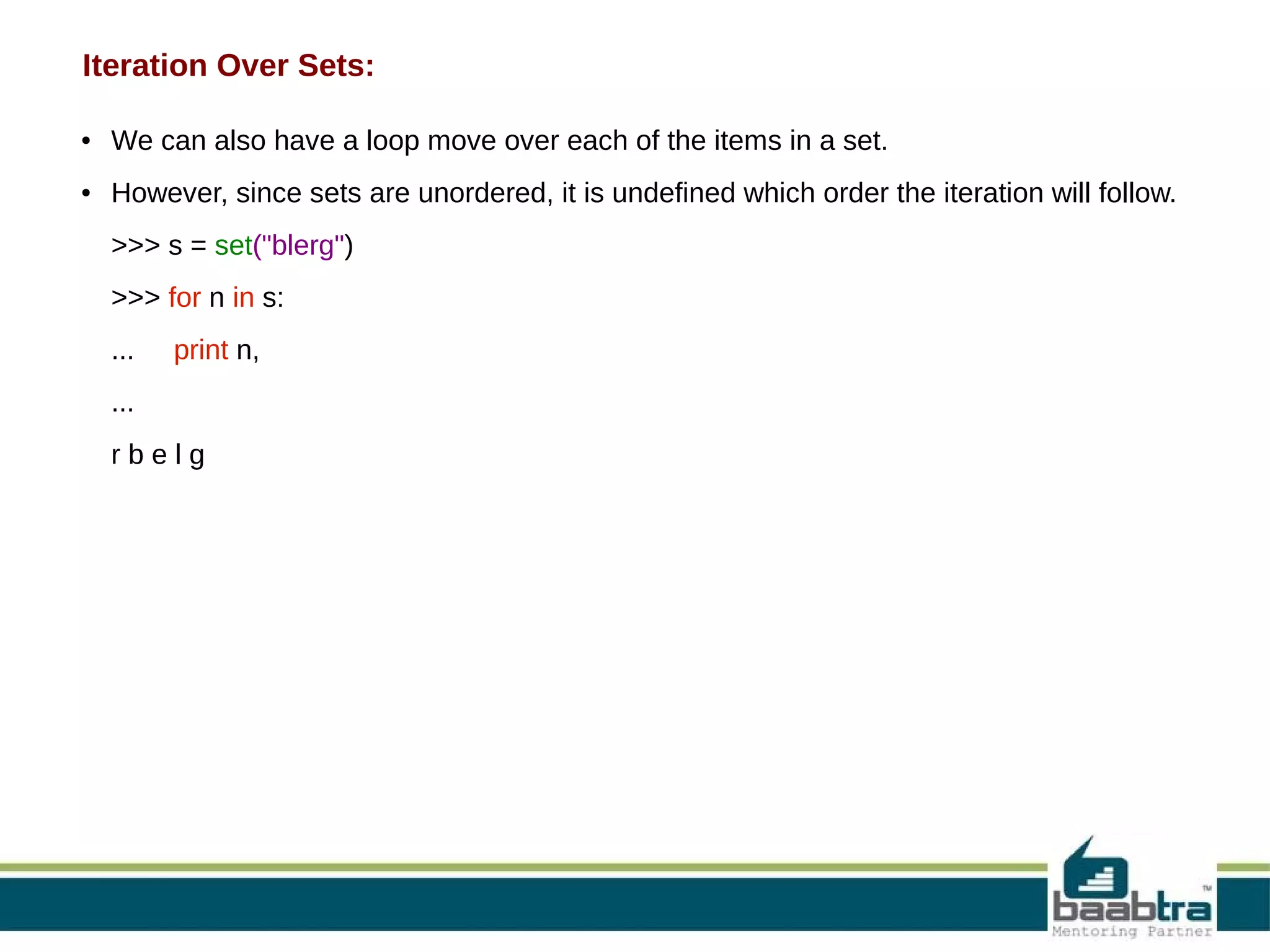This document contains information about a mentoring program run by Baabtra-Mentoring Partner. It includes:
- A disclaimer that this is not an official Baabtra document
- A table showing a mentee's typing speed progress over 5 weeks
- An empty table to track jobs applied to by the mentee
- An explanation of sets in Python, including how to construct, manipulate, perform operations on, and iterate over sets
- Contact information for Baabtra





![Sets:
●
●
●
A set is an unordered collection of objects, unlike sequence objects such as lists and
tuples
Sets cannot have duplicate members - a given object appears in a set 0 or 1 times
All members of a set have to be hashable, just like dictionary keys
●
Integers, floating point numbers, tuples, and strings are hashable
process
●
dictionaries, lists, and other sets (except frozensets) are not.
●
Eg:
set(['b', 'e', 'o', 's', 'u', 't'])
set([32, 26, 12, 54])](https://image.slidesharecdn.com/setsinpython-131116001627-phpapp01/75/Sets-in-python-6-2048.jpg)
![Constructing Sets:
One way to construct sets is by passing any sequential object to the "set"
constructor
●
>>> set([0, 1, 2, 3])
set([0, 1, 2, 3])
>>> set("obtuse")
set(['b', 'e', 'o', 's', 'u', 't'])
●
Add elements to sets
>>> s = set([12, 26, 54])
>>> s.add(32)
>>> s
set([32, 26, 12, 54])](https://image.slidesharecdn.com/setsinpython-131116001627-phpapp01/75/Sets-in-python-7-2048.jpg)
![●
Update set:
>>> s.update([26, 12, 9, 14])
>>> s
set([32, 9, 12, 14, 54, 26])
●
Copy set:
●
The set function also provides a copy constructor. However, remember that the copy
constructor will copy the set, but not the individual elements
>>> s2 = s.copy()
>>> s2
set([32, 9, 12, 14, 54, 26])](https://image.slidesharecdn.com/setsinpython-131116001627-phpapp01/75/Sets-in-python-8-2048.jpg)
![Membership Testing:
●
We can check if an object is in the set using the same "in" operator as with
sequential data types
>>> 32 in s
True
>>> 6 in s
False
>>> 6 not in s
True
●
We can also test the membership of entire sets. Given two sets s1 and s2 , we
check if s1 is a subset or a superset of s2
>>> s.issubset(set([32, 8, 9, 12, 14, -4, 54, 26, 19]))
True
>>> s.issuperset(set([9, 12]))
True](https://image.slidesharecdn.com/setsinpython-131116001627-phpapp01/75/Sets-in-python-9-2048.jpg)
![●
Note that the <= and >= operators also express the issubset and issuperset functions
respectively.
>>> set([4, 5, 7]) <= set([4, 5, 7, 9])
True
>>> set([9, 12, 15]) >= set([9, 12])
True
Removing Items:
●
●
There are three functions which remove individual items from a set, called pop,
remove, and discard
The first, pop, simply removes an item from the set
>>> s = set([1,2,3,4,5,6])
>>> s.pop()
1
>>> s
set([2,3,4,5,6])](https://image.slidesharecdn.com/setsinpython-131116001627-phpapp01/75/Sets-in-python-10-2048.jpg)
![●
We also have the "remove" function to remove a specified element.
>>> s.remove(3)
>>> s
set([2,4,5,6])
●
However, removing a item which isn't in the set causes an error.
>>> s.remove(9)
Traceback (most recent call last):
File "<stdin>", line 1, in ?
KeyError: 9
●
We also have another operation for removing elements from a set,
clear, which simply removes all elements from the set
>>> s.clear()
>>> s
set([])](https://image.slidesharecdn.com/setsinpython-131116001627-phpapp01/75/Sets-in-python-11-2048.jpg)

![Set Operations:
●
Python allows us to perform all the standard mathematical set operations,
using members of set
●
Union
The union is the merger of two sets. Any element in s1 or s2 will appear
in their union
>>> s1 = set([4, 6, 9])
>>> s2 = set([1, 6, 8])
>>> s1.union(s2)
set([1, 4, 6, 8, 9])
>>> s1 | s2
set([1, 4, 6, 8, 9])](https://image.slidesharecdn.com/setsinpython-131116001627-phpapp01/75/Sets-in-python-13-2048.jpg)
![●
Intersection
●
Any element which is in both s1 and s2 will appear in their intersection
>>> s1 = set([4, 6, 9])
>>> s2 = set([1, 6, 8])
>>> s1.intersection(s2)
set([6])
>>> s1 & s2
set([6])
>>> s1.intersection_update(s2)
>>> s1
set([6])
●
Symmetric Difference
●
The symmetric difference of two sets is the set of elements which
are in one of either set, but not in both
>>> s1 = set([4, 6, 9])
>>> s2 = set([1, 6, 8])
>>> s1.symmetric_difference(s2)
set([8, 1, 4, 9])
>>> s1 ^ s2
set([8, 1, 4, 9])
>>> s1.symmetric_difference_update(s2)
>>> s1
set([8, 1, 4, 9])](https://image.slidesharecdn.com/setsinpython-131116001627-phpapp01/75/Sets-in-python-14-2048.jpg)
![Set Difference
●
●
Python can also find the set difference of s1 and s2 , which is the elements that
are in s1 but not in s2.
>>> s1 = set([4, 6, 9])
>>> s2 = set([1, 6, 8])
>>> s1.difference(s2)
set([9, 4])
>>> s1 - s2
set([9, 4])
>>> s1.difference_update(s2)
>>> s1
set([9, 4])
Multiple sets:
●
Starting with Python 2.6, "union", "intersection", and "difference" can work with
multiple input by using the set constructor. For example,
>>> s1 = set([3, 6, 7, 9])
>>> s2 = set([6, 7, 9, 10])
>>> s3 = set([7, 9, 10, 11])
>>> set.intersection(s1, s2, s3)
set([9, 7])](https://image.slidesharecdn.com/setsinpython-131116001627-phpapp01/75/Sets-in-python-15-2048.jpg)
![Frozenset:
●
●
●
A frozenset is basically the same as a set, except that it is immutable once it is created, its members cannot be changed
Since they are immutable, they are also hashable, which means that
frozensets can be used as members in other sets and as dictionary keys
frozensets have the same functions as normal sets, except none of the
functions that change the contents (update, remove, pop, etc.) are
available
>>> fs = frozenset([2, 3, 4])
>>> s1 = set([fs, 4, 5, 6])
>>> s1
set([4, frozenset([2, 3, 4]), 6, 5])
>>> fs.intersection(s1)
frozenset([4])
>>> fs.add(6)
Traceback (most recent call last):
File "<stdin>", line 1, in <module>
AttributeError: 'frozenset' object has no attribute
'add'](https://image.slidesharecdn.com/setsinpython-131116001627-phpapp01/75/Sets-in-python-16-2048.jpg)

